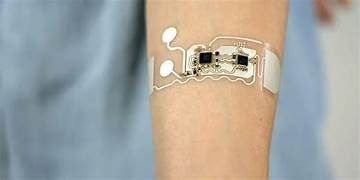
Wearable Health Sensors: The Doctor on Your Wrist.
Wearable health sensors are revolutionizing personal healthcare by transforming everyday devices like smartwatches, bands, and clothing into continuous health monitors. By tracking vital signs, activity, sleep, and stress in real time, these devices empower individuals to take control of their well-being, enable early detection of diseases, support preventive care, and integrate seamlessly into modern, data-driven healthcare systems.
✨ Raghav Jain

Introduction
Imagine having a doctor who never sleeps, never takes a break, and constantly monitors your heart rate, blood oxygen, sleep quality, and stress levels—right on your wrist. This is no longer science fiction. Wearable health sensors, integrated into smartwatches, fitness bands, and even clothing, have turned personal healthcare into a 24/7 reality. From detecting irregular heartbeats to predicting stress episodes, these miniaturized marvels are transforming preventive medicine, empowering individuals, and reshaping the global healthcare industry.
In a world increasingly dominated by data-driven decisions, wearable health sensors have emerged as a powerful bridge between technology and biology. The shift from reactive to proactive health monitoring is saving lives and reducing the burden on traditional healthcare systems. This article explores how wearable health technology works, its evolution, impact, challenges, and what the future holds for this “doctor on your wrist.”
The Evolution of Wearable Health Technology
The journey of wearable health sensors began modestly in the 1960s, when athletes started using simple heart rate monitors to enhance performance. However, it wasn’t until the early 2000s that these devices evolved into consumer-friendly gadgets. The launch of fitness trackers like Fitbit and smartwatches like the Apple Watch marked the beginning of an era where health and technology merged seamlessly.
Today’s wearables are equipped with advanced biosensors capable of measuring heart rate variability (HRV), electrocardiograms (ECG), blood oxygen saturation (SpO₂), glucose levels, body temperature, and even hydration levels. The evolution of artificial intelligence (AI), Internet of Things (IoT), and nanotechnology has made it possible to capture and analyze health metrics with near-clinical accuracy—all without the need for invasive procedures.
How Wearable Health Sensors Work
At the core of wearable devices are sensors that convert physical or biological data into digital signals. These sensors track physiological changes through the skin, blood flow, or motion. The most common technologies include:
- Optical Sensors (PPG – Photoplethysmography):
- These use light-emitting diodes (LEDs) to measure changes in blood volume beneath the skin, helping to track heart rate and oxygen saturation.
- Electrodermal Sensors:
- These detect electrical changes on the skin’s surface, providing insights into stress, emotion, and sympathetic nervous system activity.
- Accelerometers and Gyroscopes:
- These measure motion, orientation, and activity levels to track steps, workouts, sleep patterns, and even falls.
- Temperature Sensors:
- Used to monitor core body temperature variations—helpful in detecting fever, menstrual cycles, and metabolic changes.
- Electrocardiogram (ECG) Sensors:
- Found in advanced smartwatches, these measure the electrical activity of the heart to detect irregular rhythms such as atrial fibrillation.
- Glucose and Sweat Sensors:
- The latest generation of wearables can analyze sweat or interstitial fluid to track glucose levels, hydration, and electrolyte balance in real time.
All the collected data is transmitted to smartphone apps or cloud-based platforms, where AI algorithms analyze patterns and provide actionable health insights. These insights can alert users or even send automatic notifications to healthcare providers during emergencies.
Applications in Modern Healthcare
Wearable health sensors are not just fitness gadgets; they are becoming vital tools for diagnosis, disease management, and preventive care. Their real-world applications include:
- Cardiovascular Health:
- Smartwatches can detect arrhythmias, monitor heart rate variability, and even identify early signs of cardiac arrest. Many users have reported that wearables helped them seek timely medical help.
- Diabetes Management:
- Continuous Glucose Monitors (CGMs) integrated with wearables provide real-time glucose readings without finger pricks, alerting users when sugar levels deviate from normal.
- Sleep and Stress Analysis:
- Wearables can monitor sleep quality, REM cycles, and breathing patterns, providing suggestions for better rest. Electrodermal activity sensors detect stress and guide users with relaxation exercises.
- Women’s Health:
- Devices like the Fitbit Sense and Apple Watch can track menstrual cycles, fertility windows, and even detect temperature changes linked to ovulation.
- Elderly Care:
- Fall detection sensors automatically notify emergency contacts if a user experiences a sudden fall. GPS-enabled wearables also help caregivers monitor patients with Alzheimer’s or dementia.
- Fitness and Sports:
- Athletes use wearable sensors to optimize performance, prevent overtraining, and track recovery metrics like oxygen consumption (VO₂ max) and heart rate recovery.
- Public Health Monitoring:
- During the COVID-19 pandemic, wearables helped track changes in heart rate and temperature that could indicate early infection, offering potential for future epidemic surveillance.
Benefits: Empowering Individuals and Healthcare Systems
Wearable health sensors provide a multitude of benefits that extend far beyond convenience.
- Early Detection of Diseases: Continuous monitoring allows early identification of potential health issues before they escalate into serious conditions.
- Patient Empowerment: Real-time feedback encourages users to take responsibility for their health, make informed choices, and stay motivated.
- Cost Reduction: Preventive monitoring reduces hospital admissions and healthcare costs.
- Remote Healthcare (Telemedicine): Doctors can monitor patients from afar, ensuring timely interventions.
- Data-Driven Insights: The massive datasets generated by wearables contribute to population health research and personalized treatment plans.
This democratization of healthcare empowers people to become active participants in their wellness journey rather than passive patients.
Challenges and Concerns
Despite their potential, wearable health sensors face several challenges:
- Accuracy and Reliability:
- Not all wearables deliver medical-grade accuracy. Factors like skin tone, sweat, and motion can affect readings.
- Data Privacy and Security:
- Continuous monitoring generates sensitive personal data. Ensuring its protection against cyberattacks and misuse remains a major concern.
- Regulatory Oversight:
- Wearables fall in a gray area between consumer gadgets and medical devices. Regulatory frameworks by agencies like the FDA are evolving but inconsistent globally.
- User Dependence and Anxiety:
- Over-reliance on health data can lead to “health anxiety,” where users misinterpret normal fluctuations as alarming conditions.
- Integration with Healthcare Systems:
- Most wearables function independently of hospitals and clinics. A lack of standardized data integration hampers their full potential.
- Affordability and Accessibility:
- Advanced devices remain expensive and inaccessible to low-income populations, widening the health-tech gap.
The Future of Wearable Health Sensors
The next generation of wearable sensors will blur the line between technology and biology. Future innovations include:
- Smart Clothing and Tattoos: Fabrics embedded with sensors and temporary electronic tattoos that can monitor body functions discreetly.
- AI-Driven Predictive Health: Machine learning algorithms that predict illnesses before symptoms appear.
- Non-Invasive Glucose and Blood Pressure Monitoring: Research is advancing toward sensors that measure blood sugar and pressure without needles or cuffs.
- Integration with Healthcare AI Platforms: Doctors will soon use real-time wearable data for precise, continuous treatment adjustments.
- Neural Wearables: Devices that can monitor brain activity to detect mental health issues or improve focus and cognition.
By 2030, experts predict that wearable health technology will become as indispensable as smartphones—an essential part of human life and healthcare infrastructure.
Impact on Society and Healthcare Ecosystems
Wearable health sensors are driving a paradigm shift from treatment-based healthcare to prevention-based healthcare. This shift reduces hospital workloads, promotes healthier lifestyles, and helps governments manage public health crises more efficiently. Insurers are already incentivizing users who adopt health-monitoring wearables, recognizing the potential to lower claims through preventive care.
Moreover, these devices are fostering personalized medicine—where healthcare decisions are tailored to an individual’s unique physiological data. As cloud computing and AI become more sophisticated, wearable data will integrate seamlessly into electronic health records, offering doctors a complete, dynamic picture of patient health.
Ethical and Societal Implications
While wearables promise empowerment, they also raise ethical questions about who owns and controls personal health data. Should tech companies, healthcare providers, or individuals have ultimate authority? The debate intensifies as wearable data becomes valuable for pharmaceutical research, insurance underwriting, and marketing analytics. Hence, transparency, user consent, and strong digital governance will determine whether wearable health sensors become truly liberating—or subtly intrusive.
Wearable health sensors have emerged as one of the most groundbreaking innovations in modern healthcare, transforming the way individuals monitor their physical and physiological well-being, effectively placing a miniaturized, always-on “doctor” directly on the wrist or integrated into clothing, and enabling continuous health monitoring that was once confined to clinical settings, offering users unprecedented insight into their own bodies and empowering them to take proactive measures toward maintaining optimal health; these devices, which range from smartwatches and fitness bands to advanced biosensor-equipped garments, rely on a combination of sophisticated sensors, artificial intelligence, and connectivity technologies to collect, analyze, and interpret vital health metrics such as heart rate, heart rate variability, electrocardiograms (ECG), blood oxygen saturation (SpO₂), sleep patterns, stress levels, physical activity, hydration, and even glucose or electrolyte levels in some cutting-edge models, and they operate by converting physiological signals into digital data using optical sensors like photoplethysmography (PPG), which emits light through the skin to measure changes in blood volume, or electrical sensors that detect minute variations in skin conductance to assess stress and sympathetic nervous system activity, while accelerometers and gyroscopes capture motion and orientation, enabling activity tracking, fall detection, and sleep stage analysis, and temperature sensors provide continuous monitoring of core body temperature fluctuations, which can indicate fever, metabolic changes, or ovulatory cycles in women, all of which are then transmitted to companion smartphone applications or cloud-based platforms, where advanced machine learning algorithms interpret the data, identify patterns, detect anomalies, and generate actionable health insights; the applications of wearable health sensors extend far beyond simple fitness tracking, encompassing crucial roles in cardiovascular monitoring by detecting arrhythmias and irregular heart rhythms that could signal atrial fibrillation or other potentially life-threatening conditions, in diabetes management through non-invasive or minimally invasive continuous glucose monitoring that alerts users to dangerous fluctuations in blood sugar, in mental and emotional well-being by tracking stress levels and sleep quality, and in preventive healthcare by providing early warning signals for conditions that may otherwise remain unnoticed until severe symptoms appear, effectively shifting the healthcare paradigm from reactive treatment to proactive intervention, and allowing individuals to engage with their health data in a personalized and informed manner, while also enabling remote healthcare providers to monitor patients in real-time, thereby improving outcomes, reducing hospitalizations, and lowering healthcare costs; moreover, these devices are making significant contributions to public health research and epidemiology, as aggregated anonymized data from millions of users can help identify trends, detect outbreaks, and inform health policy, exemplified during the COVID-19 pandemic when changes in resting heart rates and temperature detected by wearables were used to predict early infections in populations, highlighting their potential to revolutionize population-level health monitoring; however, despite their promise, wearable health sensors face several challenges, including the need for improved accuracy and reliability, as external factors such as skin tone, motion, sweat, and sensor placement can affect readings, the imperative to safeguard sensitive health data against cyber threats and unauthorized access, regulatory uncertainties in classifying devices as consumer electronics or medical instruments, and potential over-reliance by users that can induce anxiety or misinterpretation of normal physiological variations, along with the need to integrate wearable data into conventional healthcare systems to fully realize their clinical utility, a challenge that requires standardized data protocols, interoperability, and collaboration between technology developers, healthcare providers, and policymakers; additionally, the affordability and accessibility of advanced wearable sensors remain a barrier for widespread adoption, particularly in low-income regions, raising concerns about health inequities and emphasizing the importance of designing cost-effective and user-friendly devices that can serve diverse populations; looking ahead, the future of wearable health sensors is extraordinarily promising, with ongoing research focused on developing smart clothing embedded with nanotechnology-based biosensors, temporary electronic tattoos that seamlessly adhere to the skin to monitor vital signs, non-invasive continuous monitoring of blood pressure and glucose, AI-driven predictive analytics capable of forecasting potential health events before symptoms manifest, and neural wearables that can assess cognitive function, mental health, and emotional states, all of which point toward a world in which healthcare is deeply personalized, continuous, and integrated into daily life, enabling individuals to maintain well-being proactively rather than merely reacting to illness, and creating a healthcare ecosystem where prevention, prediction, and personalization are at the forefront; in essence, wearable health sensors are not merely gadgets or fitness accessories—they are transformative tools that empower users to understand their own bodies, provide clinicians with continuous actionable data, enhance preventive and personalized care, reduce the burden on traditional healthcare infrastructure, and pave the way for a future where the line between human biology and technology is increasingly seamless, fundamentally changing how society approaches health, wellness, and longevity, and ensuring that everyone, from athletes to the elderly, can benefit from real-time, data-driven insights into their physical condition, ultimately turning everyday life into a continuous, intelligent health monitoring experience that embodies the concept of having a doctor on your wrist, ready to guide, alert, and inform at every moment, while also posing important questions about ethics, privacy, accessibility, and responsible use, which must be addressed to fully harness the potential of this remarkable technological evolution.
Wearable health sensors have rapidly transformed from simple step counters and heart rate monitors into sophisticated, multifunctional devices capable of tracking a wide array of physiological and health-related metrics, effectively placing a personal health assistant directly on the wrist or integrated seamlessly into clothing, accessories, or even temporary tattoos, allowing users to monitor their well-being in real time and take proactive measures toward maintaining optimal health, and this transformation has been made possible by the integration of advanced sensor technologies such as photoplethysmography, which uses light to detect blood volume changes to calculate heart rate and oxygen saturation, electrocardiogram sensors capable of detecting arrhythmias and other cardiac anomalies, accelerometers and gyroscopes that track physical activity, steps, movement patterns, sleep cycles, and falls, electrodermal sensors that gauge stress by measuring changes in skin conductance, temperature sensors for monitoring core body temperature fluctuations that can signal fever or metabolic changes, and even emerging non-invasive glucose and hydration sensors that analyze sweat or interstitial fluid to provide real-time feedback on hydration and blood sugar levels, all of which are coupled with powerful algorithms and artificial intelligence that analyze collected data to identify patterns, detect anomalies, and provide actionable insights, and the implications of this continuous, data-driven monitoring are profound, as it enables early detection of cardiovascular conditions such as atrial fibrillation, continuous management of chronic illnesses like diabetes and hypertension, optimization of athletic performance through detailed tracking of activity levels, oxygen consumption, and recovery metrics, improved sleep quality by monitoring sleep stages and disturbances, mental health management through stress monitoring and biofeedback, and enhanced women’s health care via tracking of menstrual cycles, ovulation, and hormonal fluctuations, making wearable sensors not merely tools for fitness enthusiasts but crucial instruments in preventive, personalized, and patient-centered healthcare, while simultaneously empowering individuals to take ownership of their health decisions by providing immediate feedback and trends over time that can influence lifestyle choices, dietary habits, exercise routines, and medication adherence, and in addition to personal benefits, wearable health sensors have significant implications for broader healthcare systems, as the aggregation of anonymized, population-level data can inform public health strategies, detect early outbreaks of disease, and contribute to large-scale epidemiological research, with real-world examples including the role of wearables during the COVID-19 pandemic, where subtle changes in resting heart rate, temperature, and activity levels detected by millions of users provided early indicators of infection, demonstrating the potential for wearables to complement traditional disease surveillance systems and offer proactive health interventions on a population scale, yet despite the promise of these devices, challenges remain that must be addressed to ensure accuracy, reliability, privacy, and accessibility; for instance, sensor accuracy can be affected by external factors such as skin pigmentation, motion artifacts, improper placement, or environmental conditions, leading to potential false positives or negatives that could mislead users, and while high-end devices like the Apple Watch or Fitbit Sense have achieved near-clinical accuracy for specific metrics, many lower-cost alternatives lack medical-grade reliability, underscoring the importance of validating wearable data against standardized clinical measurements, moreover, the continuous collection of highly sensitive health data raises significant privacy and cybersecurity concerns, as breaches or unauthorized access could expose personal information, medical history, or behavioral patterns to malicious actors or commercial exploitation, and this has prompted regulatory bodies like the FDA, CE, and other authorities to develop guidelines for medical-grade wearables, yet global regulatory frameworks remain inconsistent, creating uncertainty for both manufacturers and consumers, further complicating integration of wearable data into conventional healthcare workflows, which requires interoperability with electronic health records, secure cloud storage, and physician-friendly analytics, and beyond technological and regulatory considerations, there are psychological and societal implications to consider, such as the risk of health anxiety or obsessive monitoring, where users may misinterpret minor fluctuations in heart rate or sleep quality as alarming, and there are also equity concerns, as high-cost wearable devices may be inaccessible to low-income populations, potentially exacerbating health disparities, and while insurers are beginning to incentivize wearable use through wellness programs, universal access and affordability remain critical challenges to ensuring these technologies benefit all segments of society, looking ahead, the future of wearable health sensors is poised for remarkable expansion, with innovations including smart textiles and clothing embedded with nanosensors that continuously measure vital signs without being obtrusive, temporary electronic tattoos that adhere to the skin and track bioelectric activity or hydration, non-invasive blood pressure and glucose monitoring that eliminates the need for needles or cuffs, AI-driven predictive health models capable of forecasting disease onset before symptoms appear, neural wearables that monitor brain activity for mental health and cognitive performance, and fully integrated platforms that allow seamless communication between wearable devices, healthcare providers, and cloud-based analytics for dynamic, personalized care plans, and as these technologies mature, they will likely reshape the healthcare landscape, making preventive, data-driven, and individualized care the norm rather than the exception, shifting the focus from reactive treatment in hospitals to proactive self-care and remote clinical oversight, ultimately allowing individuals to live healthier, longer lives with fewer emergency interventions and reduced healthcare costs, while also generating valuable insights for medical research, public health, and policy development, and despite the challenges that remain in terms of accuracy, data security, ethical use, and universal access, wearable health sensors represent a paradigm shift in healthcare, transforming everyday objects into powerful health monitoring tools, democratizing access to health insights, fostering patient empowerment, and bridging the gap between technology and biology to create a future where everyone can have a personal “doctor on their wrist,” ready to alert, guide, and inform in real time, effectively redefining the relationship between humans and their own health, and positioning wearable technology as a cornerstone of preventive medicine, personalized care, and continuous monitoring for decades to come.
Conclusion
Wearable health sensors represent one of the most transformative innovations in modern healthcare. By continuously monitoring vital signs and providing real-time feedback, they enable individuals to take proactive control of their well-being. From heart rate tracking to glucose monitoring and sleep analysis, these devices act as a “doctor on your wrist,” making healthcare personal, predictive, and preventive.
However, with great potential comes responsibility. Ensuring data privacy, accuracy, affordability, and ethical use is essential to sustain public trust and global adoption. The future of wearable health sensors lies not just in technology but in collaboration—between engineers, doctors, policymakers, and users.
As healthcare moves from hospitals to homes, these wearable companions are no longer mere accessories—they are life-saving allies redefining how humanity perceives and practices health.
Q&A Section
Q1: What are wearable health sensors?
Ans: Wearable health sensors are compact electronic devices integrated into accessories like watches, bands, or clothing that continuously monitor physiological parameters such as heart rate, oxygen saturation, sleep quality, stress levels, and physical activity.
Q2: How do wearable health sensors work?
Ans: They use advanced biosensors such as optical (PPG), electrodermal, and temperature sensors to detect changes in the body. The collected data is analyzed using AI algorithms to provide real-time health insights and alerts.
Q3: What are the benefits of using wearable health devices?
Ans: They enable early disease detection, promote preventive healthcare, reduce hospital visits, empower users with real-time feedback, and support remote monitoring by doctors.
Q4: Can wearable sensors replace doctors?
Ans: No, they cannot replace doctors but can complement them by providing continuous data that helps in early diagnosis, better decision-making, and preventive care.
Q5: Are wearable health devices accurate?
Ans: Accuracy varies by brand and sensor type. While premium models like Apple Watch and Fitbit Sense offer near-clinical accuracy, cheaper models may produce less reliable results.
Similar Articles
Find more relatable content in similar Articles

Wearable Health Sensors: The D..
Wearable health sensors are re.. Read More

Protecting Kids in the Digital..
In an increasingly connected w.. Read More

Data Centers and the Planet: M..
As cloud computing becomes the.. Read More

Digital DNA: The Ethics of Gen..
Digital DNA—the digitization a.. Read More
Explore Other Categories
Explore many different categories of articles ranging from Gadgets to Security
Smart Devices, Gear & Innovations
Discover in-depth reviews, hands-on experiences, and expert insights on the newest gadgets—from smartphones to smartwatches, headphones, wearables, and everything in between. Stay ahead with the latest in tech gear
Apps That Power Your World
Explore essential mobile and desktop applications across all platforms. From productivity boosters to creative tools, we cover updates, recommendations, and how-tos to make your digital life easier and more efficient.
Tomorrow's Technology, Today's Insights
Dive into the world of emerging technologies, AI breakthroughs, space tech, robotics, and innovations shaping the future. Stay informed on what's next in the evolution of science and technology.
Protecting You in a Digital Age
Learn how to secure your data, protect your privacy, and understand the latest in online threats. We break down complex cybersecurity topics into practical advice for everyday users and professionals alike.
© 2025 Copyrights by rTechnology. All Rights Reserved.